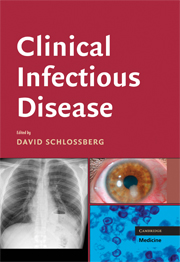Book contents
- Frontmatter
- Contents
- Preface
- Contributors
- Part I Clinical Syndromes – General
- Part II Clinical Syndromes – Head and Neck
- Part III Clinical Syndromes – Eye
- 11 Conjunctivitis
- 12 Keratitis
- 13 Iritis
- 14 Retinitis
- 15 Endophthalmitis
- 16 Periocular Infections
- Part IV Clinical Syndromes – Skin and Lymph Nodes
- Part V Clinical Syndromes – Respiratory Tract
- Part VI Clinical Syndromes – Heart and Blood Vessels
- Part VII Clinical Syndromes – Gastrointestinal Tract, Liver, and Abdomen
- Part VIII Clinical Syndromes – Genitourinary Tract
- Part IX Clinical Syndromes – Musculoskeletal System
- Part X Clinical Syndromes – Neurologic System
- Part XI The Susceptible Host
- Part XII HIV
- Part XIII Nosocomial Infection
- Part XIV Infections Related to Surgery and Trauma
- Part XV Prevention of Infection
- Part XVI Travel and Recreation
- Part XVII Bioterrorism
- Part XVIII Specific Organisms – Bacteria
- Part XIX Specific Organisms – Spirochetes
- Part XX Specific Organisms – Mycoplasma and Chlamydia
- Part XXI Specific Organisms – Rickettsia, Ehrlichia, and Anaplasma
- Part XXII Specific Organisms – Fungi
- Part XXIII Specific Organisms – Viruses
- Part XXIV Specific Organisms – Parasites
- Part XXV Antimicrobial Therapy – General Considerations
- Index
12 - Keratitis
from Part III - Clinical Syndromes – Eye
Published online by Cambridge University Press: 05 March 2013
- Frontmatter
- Contents
- Preface
- Contributors
- Part I Clinical Syndromes – General
- Part II Clinical Syndromes – Head and Neck
- Part III Clinical Syndromes – Eye
- 11 Conjunctivitis
- 12 Keratitis
- 13 Iritis
- 14 Retinitis
- 15 Endophthalmitis
- 16 Periocular Infections
- Part IV Clinical Syndromes – Skin and Lymph Nodes
- Part V Clinical Syndromes – Respiratory Tract
- Part VI Clinical Syndromes – Heart and Blood Vessels
- Part VII Clinical Syndromes – Gastrointestinal Tract, Liver, and Abdomen
- Part VIII Clinical Syndromes – Genitourinary Tract
- Part IX Clinical Syndromes – Musculoskeletal System
- Part X Clinical Syndromes – Neurologic System
- Part XI The Susceptible Host
- Part XII HIV
- Part XIII Nosocomial Infection
- Part XIV Infections Related to Surgery and Trauma
- Part XV Prevention of Infection
- Part XVI Travel and Recreation
- Part XVII Bioterrorism
- Part XVIII Specific Organisms – Bacteria
- Part XIX Specific Organisms – Spirochetes
- Part XX Specific Organisms – Mycoplasma and Chlamydia
- Part XXI Specific Organisms – Rickettsia, Ehrlichia, and Anaplasma
- Part XXII Specific Organisms – Fungi
- Part XXIII Specific Organisms – Viruses
- Part XXIV Specific Organisms – Parasites
- Part XXV Antimicrobial Therapy – General Considerations
- Index
Summary
Keratitis can lead to severe visual disability and requires prompt diagnosis and treatment. Sequelae can vary in severity from corneal scarring to perforation, endophthalmitis, and loss of the eye. Although the corneal surface is awash with microorganisms of the normal flora, an intact corneal epithelium and ocular defense mechanism serve to prevent infection in the normal eye. Although some organisms such as Neisseria gonorrhoeae, Neisseria meningitides, Corynebacterium diptheriae, Listeria, and Shigella can penetrate an intact epithelium, all others require damage to the epithelial layer to invade the cornea. Several risk factors predispose the cornea to infection. Dry eyes from Sjogren syndrome, Stevens-Johnson syndrome, or vitamin A deficiency can result in bacterial keratitis. Prolonged corneal exposure from ectropion, lagophthalmos or proptosis can lead to secondary infection. Entropion and trichiaisis resulting in epithelial defects put the cornea at risk. Neurotrophic keratopathy from cranial neuropathy, prior herpes simplex, or zoster infections predispose to secondary infections. Some systemic conditions such as chronic alcoholism, severe malnutrition, immunosuppressive drug use, immunodeficiency syndromes, and malignancy can impair immune defenses and allow infection by unusual organisms. Prior ocular surgery such as penetrating keratoplasty or refractive procedures are also risk factors. Trauma is a common predisposing factor of bacterial keratitis, especially for patients at the extremes of age and in developing countries. Injury to the corneal surface and stroma allows invasion of normal flora as well as organisms harbored by foreign bodies.
- Type
- Chapter
- Information
- Clinical Infectious Disease , pp. 87 - 96Publisher: Cambridge University PressPrint publication year: 2008

